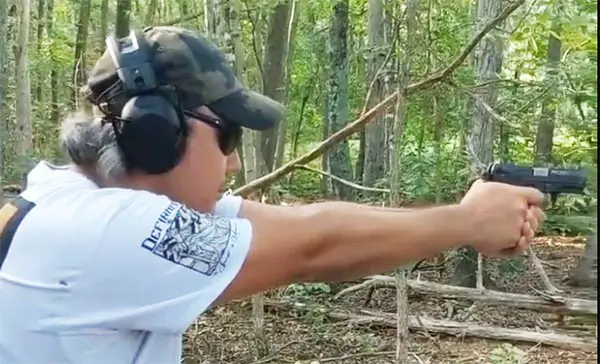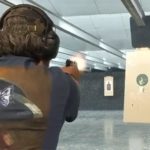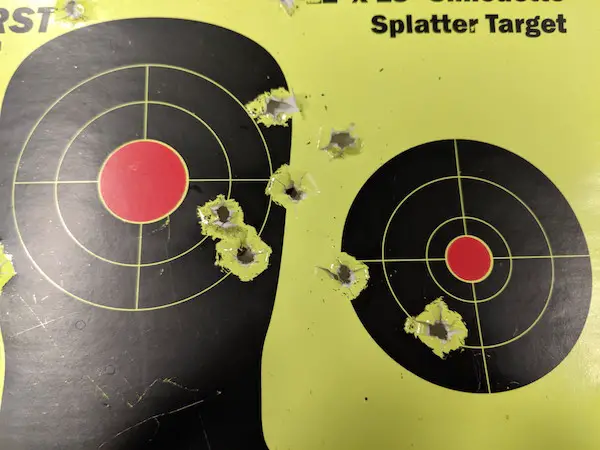If you’re a competitive shooter, or firearms enthusiast who frequents the shooting range, then you need to have quality ear protection. Not all shooting ear protection is created equal, and doubling up with ear plugs isn’t the most comfortable or ideal.
Therefore, I’m here to provide some guidance when selecting the right ear protection for your shooting needs. Whether you’re looking for standard ear pro that is comfortable and won’t break the bank, or looking for something state of the art with Bluetooth integration, I’ll cover them all.
Table of Contents
Why Shooting Ear Protection Is Mandatory
No doubt, that you’ve noticed the elderly with hearing aids adorning their ears. Unless you want to have a set of your own, you best use some kind of hearing protection while shooting. According to the NIH, noise induced hearing loss can result from one-time exposure to sounds of a certain noise level.
Although you are unlikely to experience permanent hearing loss from isolated handgun fire, you should take every precaution to protect your hearing. Most young shooters feel invincible, and fail to recognize the benefits of electronic shooting ear protection.
What Sound Level Is Detrimental To Hearing?
So, what level of decibels are detrimental to your hearing? Depending on the source, you’ll get varying opinions about what level of sound causes damage to your hearing. However, the range of sounds that can result in hearing loss is anywhere from 85-140 decibels (dB).
Surprisingly, there are many daily sounds that fall into this category. Therefore, it’s likely that repeated exposure to this level of sound would result in damage to the hearing.
What Decibel Are Gun Shots?
The decibels of sound produced by firing a round will vary. However, gun shots decibels for most common pistol calibers falls between roughly 140 and 160 decibels. When compared to the decibel range that is detrimental to hearing, you can see this is at the upper end of the limit.
Depending on a number of factors the sound will vary. For instance, subsonic ammunition will not be as loud. For a breakdown of different caliber decibel levels, you can check out this document by CAOHC.
As a general rule, the larger caliber rounds will produce louder bangs. However, the amount of powder and other factors can contribute to how loud a gun shot will be. Additionally, suppressors and other hardware can affect the sound of a gun shot.
Different Types Of Shooting Ear Protection
Now that we’ve established the importance of hearing protection, what are your options? Effectively, you have two options to protect your ears from damage when shooting. Both ear muffs and ear plugs are viable options and come in a variety of configurations.
Ear Plugs

Sound is essentially the interpretation of vibrations by your ear drum. Therefore, ear plugs inhibit the penetration of sound waves. The most basic type of ear plugs are foam inserts, more commonly referred to as “foamies.”
Foam plugs are compressed and twisted prior to inserting into the ear canal. Once inserted, the foam expands filling the canal and providing a basic level of shooting hearing protection.
Alternatively, there are also noise cancelling ear plugs, that operate much the same way as their electronic ear muff counterparts. Although these types of ear plugs are worn in a similar fashion, they actively protect the shooters’ hearing. More on the difference between active and passive protection later.
Ear Muffs

Ear muffs are the preferred method of shooting ear protection for many shooters. Unlike ear plugs, shooting ear muffs fit over the entirety of the shooters’ ear.
Each set of muffs will have a different profile. Thinner ear muffs are usually better for rifle shooting as they allow a better cheek weld with the stock. However, when shooting a pistol the ear cup profile is less important.
Similar to plugs, shooting ear muffs can also be electronic. Generally, a shooting range will provide you with basic earmuffs (not electronic). However, electronic ear pro is essential for communication if you’ll be shooting in a group or receiving verbal instruction. Therefore, it’s wise to pick up your own set to add to your range bag.
Passive v. Active Shooting Earmuffs
There are two types of shooting hearing protection; active and passive. Passive shooting ear protection provides a continuous level of static hearing defense. Foam inserts and non-electronic ear muffs fall into this category.
Because the ear pro acts as a simple barrier, all sounds regardless of decibels are muffled. This makes talking to other shooters more difficult and you’ll have to shout in order to convey your message.
Contrarily, active shooting protection engages electronic assistance when the noise level exceeds a certain threshold. Active ear protection allows shooters to communicate freely while not shooting without removing the plugs/muffs.
Once shots are fired, the sound is “cancelled” electronically. This will not completely mute the sound, so don’t be shocked if you still hear a “pop” while firing — or from adjacent lanes.
Another great feature of active ear protection, is that when it runs out of batteries it becomes a set of passive ear protection.
Double Plugging

Another not so popular technique to protect a shooters hearing is to double up your ear protection. Double plugging means using two types of shooting ear protection in conjunction. One or both sets of hearing protection can be active or passive.
Generally, this means using a set of foam ear plugs with a set of electronic ear muffs. While this does provide additional hearing protection, it negates the benefit of being able to communicate easily while not shooting.
When shooting small caliber handguns, double plugging is not a necessity to provide sufficient hearing protection. Nobody in my shooting group doubles up their hearing protection when shooting handguns.
What is NRR? (Noise Reduction Rating)
The noise reduction rating (NRR) is the standard for measurement of the ability to block sound. Each set of shooting ear protection will have an NRR rating attached. Additionally, the higher the NRR rating the greater the protection offered.
What’s The Highest NRR Rating?
Depending on what type of shooting ear protection you are looking for, the NRR rating will vary. Generally, passive ear protection is going to have a higher NRR rating; between 25 and 37. Contrarily, active ear protection will have an NRR rating between 21 and 26.
Prior to picking up my own ear pro, I did a fair amount of poking around the internet and speaking with other shooters. I didn’t spend much time on passive hearing protection research, because I knew I wanted active hearing protection.
If you’re interested in the math behind the NRR protection ratings, I suggest checking out this page from noisemeters. This will give you a more accurate representation of what your earmuffs, or plugs, are doing to protect your hearing.
SNR v. NRR
Depending on where you are, the NRR rating may not be the standard. In the EU, SNR is used to measure the effective protection a device offers. The methodology is different for SNR. However, since most of my readers reside in the U.S. I use NRR as my standard. Looking to learn more? You can check out this article which is more in depth.
Best Shooting Ear Protection For $100

My primary ear protection is the Peltor Sport Tactical 500 (pictured above). I’ve used this set of ear protection for indoor and outdoor shooting. Since I usually shoot handguns, the profile doesn’t bother me. However, if you’ll be shooting different rifles you may want a set of electronic hearing protection with a slimmer profile.
You can read a more in-depth review here. However, based on all of the ear muffs I’ve had the opportunity to test, the Peltor Sport Tactical 500 is the best electronic ear protection at $100 price tag.
Parting Shots
On any given day at the range, I could be shooting multiple different types of firearms. Therefore, I keep several different types of hearing protection in my range bag. This includes both active and passive sets of ear pro. Plus, I never know if a new shooter will be joining us who doesn’t have their own ears and eyes.
Hopefully, this article has given you some insight into the necessity of hearing protection on the range. Additionally, I hope you have sufficient information for selecting a set of hearing protection that works for your needs. If you found this article helpful please leave a comment or share with your social network. It helps me out immensely.










